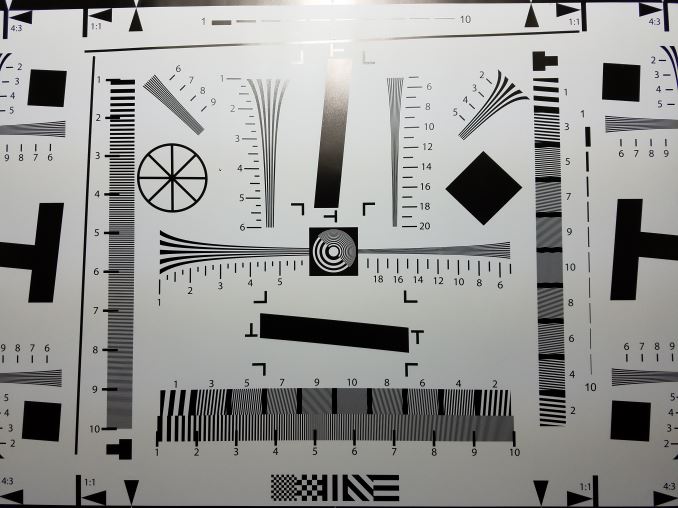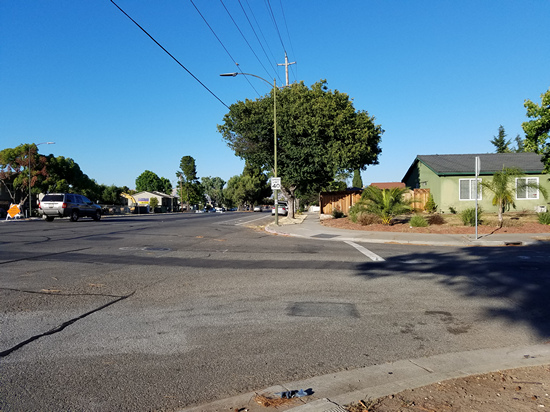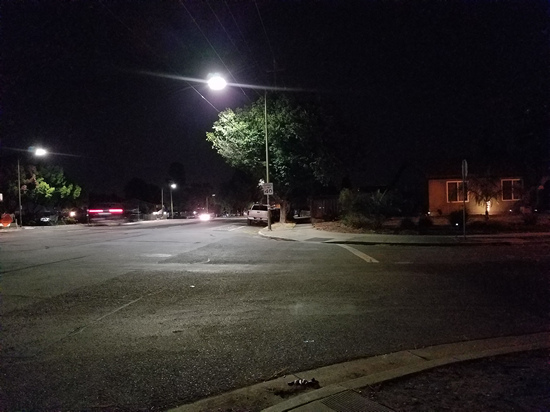The Samsung Galaxy S7 and S7 edge Review: Part 2
by Joshua Ho on July 5, 2016 8:00 AM ESTStill Image Performance
Now that we’ve covered the user experience associated with the camera, we can start to go over the output that the Galaxy S7 is capable of producing. In order to do this we continue to carry over the same sorts of benchmarks that we’ve used in 2015, which is to say that we use a combination of standardized test charts with semi-controlled lighting along with real world testing to try and see how the device actually performs outside of rather simplistic tests.
Starting with the ISO chart we can see quite clearly that the Galaxy S7 has lost noticeable ground in resolution relative to the Galaxy S6 when you look at the center of the photo, but at the edges of the photo the Galaxy S7 actually appears to have the lead against the Galaxy S6. The same sort of story plays out with the HTC 10 as it clearly has more detail than the Galaxy S7 at the center of the photo but the edges of the HTC 10’s test chart shot shows clear defocus that gets pretty terrible at the corners.
| Daytime Photography |
In our daytime landscape test we can see the sorts of effects that the smaller pixel size has had on the Galaxy S7. Relative to the Galaxy S6, there’s almost no delta in the detail resolved, but right away it’s obvious that the sharpening halos have become even more obvious than before which is concerning. These observations also apply to the Galaxy Note5, although the Note5 is a bit sharper due to some changes in image processing relative to the Galaxy S6. However I wouldn’t say that there’s an appreciable difference one way or another here.
Relative to the iPhone 6s, the Galaxy S7 is basically identical in detail as well, but the iPhone 6s tends a bit warmer and has much, much less obvious post-processing that is extremely obvious on the distant trees that contrast against the sky. This is actually kind of surprising for me given that the Galaxy S7 has a larger sensor, but I suspect the dual pixel AF, wider aperture, and slightly wider field of view are eliminating whatever advantages increased sensor size might bring.
Compared to the HTC 10, the Galaxy S7 has better edge contrast, but generally it looks like textures have better detail on the HTC 10. I haven’t been able to do extensive RAW comparisons yet but it looks like HTC is just blurring luminance noise out too aggressively here for whatever reason. I’m not sure what causes this in image processing, but given how other OEMs like LG and Apple are fully capable of mostly eliminating color noise from their photos while retaining most of the detail that their cameras are capturing HTC would do well to do the same.
The final point of comparison I want to make here is the LG G4/G5. Although the G5 seems to have started an AF run in the middle of the capture, the areas where the photo is actually focused are arguably better than what the Galaxy S7 can put out. Even next to the G4, the Galaxy S7 falls short. I’m honestly not sure why LG doesn’t get more credit here, because next to Apple they seem to have the best image processing algorithms in the industry.
| Low Light Photography |
While daytime quality is critical, I suspect most people are going to be interested in low light performance as this is usually the hardest test for any OEM to get through. It’s taken years for OEMs to start shipping acceptable image processing in low light that wasn’t just a smeary and oversharpened mess, so getting this right is pretty important to say the least.
Unfortunately, the Galaxy S7 is just a bit disappointing here. The LG G5 is just clearly better here as noise reduction is better in pretty much every way and it looks a lot more natural due to less obvious sharpening halos. I would also argue that the HTC 10 is also better here due to its better texture detail and better handling of shadow detail, even if edges are softer.
The Galaxy S7 also has this strange streaking light flare with bright sources that I just couldn’t get rid of despite wiping the lens multiple times with a clean cotton cloth, which was done for every phone in this test before taking the picture. In fairness, the Galaxy S7 is still the fastest camera out of everything in this test, but it comes at the cost of rather disappointing output for me. The Galaxy Note5 looks like it might even be slightly better than the Galaxy S7, which is a weird regression when the general idea of going to a larger pixel size is to get better low light performance. As alluded to earlier, the cost of the dual pixel AF system may be sensitivity due to the dual photodiodes and light barrier to generate a phase detection pixel. While this is just one test example I’ve spent a lot of time playing with the camera on the Galaxy S7 and in general its low light performance is fairly similar to what you see above. The only time where I really see the Galaxy S7 lead is in extreme low light conditions where everything is reaching ISO and shutter speed limits.
Overall, while the user experience of the Galaxy S7's camera is industry-leading, the Galaxy S7 represents a somewhat unfortunate sidegrade in camera quality at best. I would argue that Samsung has gone in the wrong direction with their camera processing as they seem to be relying on strong noise reduction and sharpening more than ever before. The Galaxy S7 also retains the oversaturated color rendering of the Galaxy S6. While I'm sure most people are happy with these results, Apple and LG tend to have more accurate color rendition with their cameras. While HTC doesn't quite nail color rendition, they are arguably closer to reality than Samsung is. Hopefully with their next device they manage to maintain their class-leading speed, but with better post-processing and overall image quality.



















266 Comments
View All Comments
LuoSKraD - Tuesday, July 5, 2016 - link
So you agree because they are bad mouthing a company and a phone you don't like? They didn't cover macro shots or anything at all it was preference. It just seemed like another iPhone biased review, undersaturation poor depth of field, bad low light quality. These are just a few examples where Iphones fail at, this was not a thorough review at all it was just focused on being biased towards making a phone look worse than it actually is. There are much better wrote and explained camera reviews out there for instance.victorson - Tuesday, July 5, 2016 - link
Don't know about AnandTech, but sure seems like you have a certain bias.retrospooty - Tuesday, July 5, 2016 - link
I have been coming to Anandtech since 1998, and have always enjoyed it's great reviews... But for the past 3-4 years, they have become very Apple-centric. The comment from LuoSKraD above is pretty correct. It all made sense when Anand himself left the site to go work for Apple, but the clear bias exists, and this review shows it. That is OK, it's not like there aren't other Apple-centric sites out there and it is perfectly withing the sites rights to run thigns the way they want to... But if you are looking for unbiased reviews on any products that compete with Apple, this site is no longer one of them, so browse accordingly.The Garden Variety - Tuesday, July 5, 2016 - link
Action, man! You're uncovering a great truth here, but we need action! Our opinion matters more than others—how do we make sure our anecdotes and opinions are enforced in all future reviews? We must keep visiting here, so how do we make sure this community only reflects our opinions? I think this is essential and I need your guidance here.retrospooty - Tuesday, July 5, 2016 - link
I dont know if we can. The site was sold to "Purch" in 2014. The same parten company that owns Toms hardware. LOL. suffice to say they arent interested in the tech, but the clicks.retrospooty - Tuesday, July 5, 2016 - link
damn typeslexia... Same "parent" company.Meteor2 - Wednesday, July 6, 2016 - link
You're being trolled :)victorson - Wednesday, July 6, 2016 - link
AT is one of very few websites that tests phones and bases its opinion on rigorous testing than most reviewers. You are entitled to your opinion about bias (as always, without any factual backing), but it's extremely irritating how all of the popular blogs praised the Galaxy S7's camera without mentioning any of its obvious flaws. That's what I call bias: ignoring the objective reality, so that an opinion of the 'best camera ever' can be manufactured and repeated to infinity. The truth, however, is different: the Galaxy S7 has a very fast camera with amazing auto-focus, but the quality of its images suffers as a result.lilmoe - Wednesday, July 6, 2016 - link
The dual pixel focusing system alone makes the GS7's camera leaps and bounds better than the competition. If a reviewer ever so slightly undermines this aspect about the GS7's camera (or any camera in that regard), or believes it's just "OK" needs to work more on their photography skills and overall knowledge.There are DSLR and mirrorless manufacturers out there that release sequels to their "pro" line cameras with the only significant upgrade being the focusing system, and pro photographers actually upgrade to that new product.
The focusing system, in short, either makes you take the image, or end up with a blurry shot where no post processing can ever help.
If you're THAT worried about post processing, then you need to be shooting RAW. I'm perfectly happy with the post processing on my GS7, and when I KNOW I need all the detail I can get (portraits, landscape, sports) then I simply launch pro mode.
jospoortvliet - Wednesday, July 6, 2016 - link
Well, I am fascinated by how different people rate the extreme sharpening Samsung employs. I find it horribly ugly and I keep hoping for either a fix or a setting to disable it on my S7. the HTC one I owned before (m7) made it configurable... please Sammy, copy that.I was surprised how undersaturated that night pic was, mine look nice and I agree the fast focus is super important.
But I do appreciate the test of the radio, that is interesting.